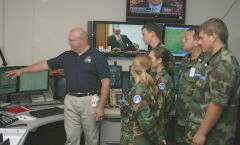Staff Sections
Main Content
NC Wing Assists During Earthquake Drill
Members assist at Emergency Ops Center
6/28/2009–Raleigh, NC–
EARTHQUAKE! Here in North Carolina natural disasters experienced more frequently are hurricanes, flash flooding, mud slides, snow, sleet and freezing rain. But on June 23 the airwaves crackled and telephone lines buzzed as reports of devastation began to trickle in to the Emergency Operations Center (EOC) located underground in the State Administration Building. Just two floors above the EOC, NC Gov. Beverly Purdue was preparing to issue a State of Emergency Proclamation. North Carolina had begun its first ever earthquake exercise.
“Few may consider North Carolina to be an earthquake-vulnerable place to live,” said Julia Jarema, Public Information Officer for the EOC, “But the state lies nestled between four seismic zones: one in eastern Tennessee, one in the southern Appalachian Mountains, one in Giles County Virginia, and one in Charleston, South Carolina. Earthquakes in any of those areas could cause significant damage in the Tar Heel state.” Jarema said that the North Carolina Division of Emergency Management scheduled the state’s first statewide earthquake exercise for June 23-24 to test their capabilities to coordinate with other agencies in responding to a widespread disaster with no advanced notice. The training scenario involves a 5.8 magnitude earthquake west of Asheville that collapses buildings, damages roads, bridges and earthen dams; and sparks numerous fires. Planners anticipate nearly 200 emergency management staff will participate in the exercise.
In NC, Civil Air Patrol is an administrative division of the state’s Dept. of Crime Control and Public Safety (CC&PS), and it had requested CAP personnel to be stationed in the EOC to observe operations. NC Wing cadets would serve as “runners” between the various emergency management offices and the EOC.
“During a real event of this magnitude,” Jarema continued, “We would call upon CAP to provide communications and aerial surveillance in the disaster zones. The cost is so much less compared to using the Air National Guard. We would use their helicopters in a few areas, but mostly we’d need them to ferry in supplies due to the destruction of roads and bridges.”
Earthquake expert, Dr. Kenneth Taylor, Chief of the NC Geological Survey Office said that since 1735 NC has experienced 22 damage-producing earthquakes, seven of those had epicenters in the state. “Four were powerful enough – at least 5.1 magnitude—to cause structural damage,” Taylor said. “The last one was back in 1981 in Henderson Co. This was a small, shallow quake that registered 3.6 on the Richter Scale,” Taylor said.
According to 1st. Lt. Sam Brandt of the Raleigh-Wake Composite Squadron, the NC Wing is providing 20 members serving in four shifts over the two day exercise.
Sub Content
- My Account
- Member Login
- Register for an account
Search
- Recent Articles
- Cunningham Field Composite Squadron Hosts Air Operations Training and Familiarization
- NC Wing CyberPatriot Preliminary State Award Winners Announced
- Tar River Composite Squadron Cadets Compete in CyberPatriot Competition
- Civil Air Patrol Remembers Veterans for Christmas
